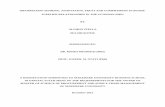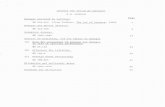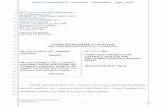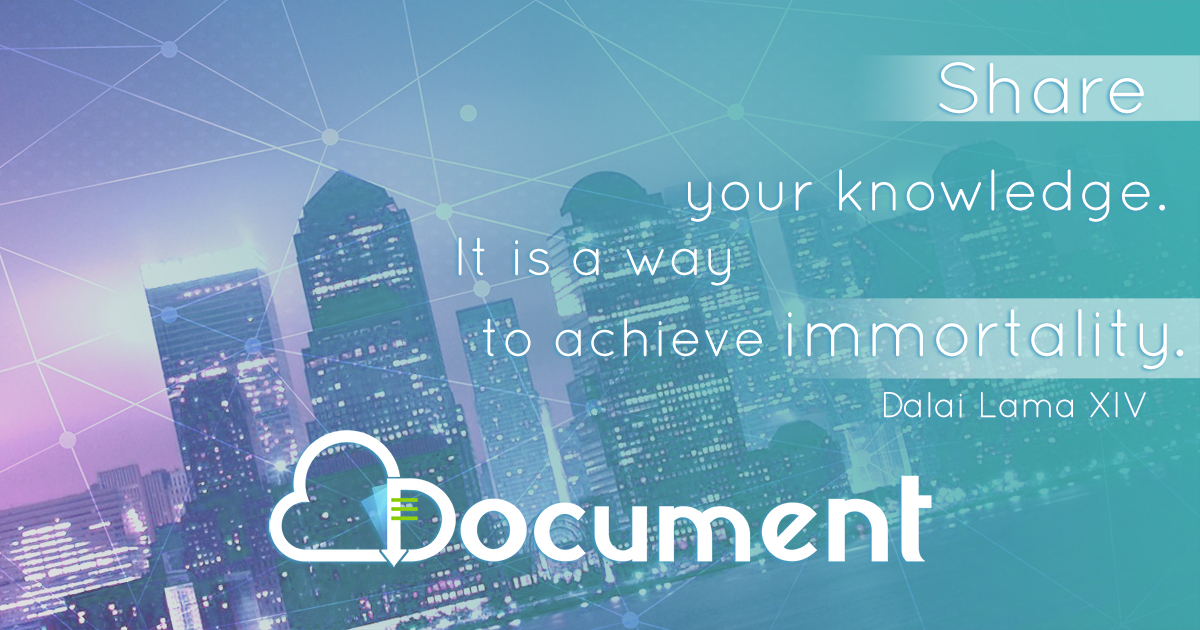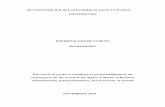Guidance on Data Breach Handling and the Giving of ... - PCPD
Caveat Venditor: Buyer Manipulation of ‘Breach’ under Article 25 of the UNCISG
-
Upload
independent -
Category
Documents
-
view
1 -
download
0
Transcript of Caveat Venditor: Buyer Manipulation of ‘Breach’ under Article 25 of the UNCISG
-2-
Introduction
International business transactions, specifically the sale of goods, have framed the global
economy through the expansion of commercial markets. In response to this, international sales
law emerged to govern transactions within the global commercial transactions community. The
terms of sales contracts between international business parties may be governed by domestic or
international law, but by party agreement, may be governed by international law in the form of
the United Nations Convention on the International Sale of Goods (“UNCISG”). The parties
indulge in a significant amount of negotiation on the substantive and procedural terms of their
sales contracts for the sake of ensuring certainty of outcome under the UNCISG in the event that
a dispute arises under the contract. Nonetheless, in the heat of a dispute which actually arises
later, a party may seize upon an allegedly ambiguous term in the contract to withdraw while
escaping liability. The other party will then have the onus of suing for breach.
The UNCISG seeks to channel party behavior in cases of dissatisfaction over the other
party’s performance in a manner which allows both parties to predict outcomes in later litigation
should withdrawal from the contract be attempted. UNCISG Article 25 provides a standard for
when one party’s dissatisfaction with the other party’s performance potentially justifies
cancelling and withdrawing from the contract. Namely, only where a breach is “fundamental” is
a dissatisfied party justified in calling off (in the terms of UNCISG, “avoiding”) the contract.
According to the Article’s legislative history, whether a particular breach is “fundamental”
depends on a showing of i) a loss of expectation/detriment element and ii) a foreseeability
element. Since fundamental breach analysis demands sifting through complex questions of
detriment, foreseeability, and prior relations inter alia, a dispute-free international business
-3-
transaction requires that the parties understand their respective interests, in both monetary and
non-monetary terms, to reduce the likelihood of substantial injury on either side.
Under the UNCISG Articles 49 and 25, the rule that identifies the degree of a seller’s
breach (which the buyer must demonstrate to justify avoiding the contract) aims to strike a
balance between freeing the buyer from a ‘failing’ commercial transaction, and protecting the
seller from suffering losses that arise from reliance and performance under the contract. The
UNCISG means to strike a balance that is both sound and desirable but the buyer can manipulate
the test (relying on the terms “detriment to expectation” and “reasonable foreseeability”), which
leads to results that contrast the UNCISG's intentions when creating this balance and the test.
The uncertainty, open to excessive discretion by the buyer under the UNCISG, jeopardizes future
business relations between parties and creates insecurity within the international business
community. Therefore, the UNCISG remedy for avoidance on fundamental breach calls for
renewed evaluation.
I. Re-evaluation of Fundamental Breach Under UNCISG Called for in View of UNCISG’s Underlying Policy Favoring Uniformity in Outcomes
To understand the remedy of avoidance, it is important to understand how rules are
interpreted under the Convention. In its goal to be recognized as a universal body of law that
should apply to international business transactions, (if the requirements of Article 1 are met), the
UNCISG places strong emphasis on independence from domestic law regarding interpretation
questions. Article 7 of the UNCISG is designed to give subscribers a guide to interpreting the
Convention. The language of Article 7 reads:
(1) In the interpretation of this Convention, regard is to be had to its international character and to the need to promote uniformity in its application and the observance of good faith in international trade.
-4-
(2) Questions concerning matters governed by this Convention which are not expressly settled in it are to be settled in conformity with the general principles on which it is based or, in the absence of such principles, in conformity with the law applicable by virtue of the rules of private international law.1
The interpretive goal of uniformity necessitates an independent interpretation of the terms of the
UNCISG itself as opposed to attaching domestic meanings that are particular to a specific legal
system. Although authorizing domestic legal systems incorporate the UNCISG, an independent
interpretation of the UNCISG should be upheld in order to promote the goal of uniformity in
worldwide application. If the language of the UNCISG was interpreted through the lens of
domestic practice, then the goal of uniformity would be futile, and parties may be enticed to
forum shop for the best system to settle their disputes.2
Article 7(2) can be deemed a ‘gap-filler’ clause which refers to general principles of
international law that construct meaning absent choice-of-law rules. This clause may be
troubling for the goal of uniformity as it is fairly easy to avoid. For example, a domestic court
may highlight numerous gaps in contract language that have no application to ‘general principles’
derived from the UNCISG. This in turn would allow a domestic court to choose their own law in
order to interpret the contract, which would more than likely lead to a choice of familiar,
domestic supplementary law. However, in order for a domestic interpretation to be compatible
with Article 7(1), it must be thoroughly examined before application.3 Therefore, the method of
interpretation used is crucial when deciding whether UNCISG Article 25 applies to a contractual
dispute. This policy favoring strict attention to uniformity applies by extension to questions not
1 Emphasis added.
2 See Franco Ferrari, Uniform Interpretation of the 1980 Uniform Sales Law, 24 Ga. J. Int’l & Comp.L., at 199 (1994); See also Recent Development: UNCISG: Specific Topics of the UNCISG in Light of Judicial Application and Scholarly Writing, 15 J.L. & Com. 1, at 9 (1995).
3 Fritz Enderlein, Uniform Law and its Application by Judges and Arbitrators, in International Uniform Law in Practice, UNIDROIT ed. p. 331-333 (1988).
-5-
just of choice of law, but also of predictable outcomes under the UNCISG where it is found to
apply.
II. Role of Cancellation Rules Governing Sale of Goods Contracts: the Example of America’s Uniform Commercial Code
A. Uniform Commercial Code (UCC)
UCC Article 2 provides for justified cancellation of contract under the “perfect tender”
rule. Under UCC §2-601, this “perfect tender” rule identifies the degree of seller’s breach,
which buyer must demonstrate to justify cancelling the contract. The rule states that buyer is
entitled to reject the entire contract “if the goods or the tender of delivery fail in any respect to
conform to the contract…”4 The buyer is then relieved of the duty “to accept and pay in
accordance with the contract.”5 Therefore, if the seller doesn’t ‘perfect’ performance on the first
try, the buyer is liberated to avoid the contract and find a different seller, so that the buyer avoids
the risk of further harm by waiting for the seller to perform as promised under the contract.
Any cancellation rule must strike a balance between two things: freeing the buyer from
further reliance on “a lost cause” once a defect appears in seller’s performance, and protecting
the seller from suffering losses through reliance the seller has already incurred under the contract
by attempting to perform thus far. However, the perfect tender rule of UCC §2-601 decides the
balance in question strongly in favor of the buyer, which is evident from the rule’s protection of
high standards of performance. Under this balance, the seller loses the opportunity to achieve
compensation for effort already expended through the eventual payment of the purchase price.
4 U.C.C. §2-601 (2002) (emphasis added).
5 U.C.C. §2-301 (2002).
-6-
The perfect tender rule is demonstrated in Bowen v. Young.6 In this case, the buyer
entered into a contract for the sale of a mobile home. After receiving his purchase, the buyer
rightfully rejected it due to non-conformance with regard to the size of the air conditioning unit.
The Court agreed with the buyer’s rejection stating that, “where goods fail “in any respect” to
conform to the contract the buyer may, under §2-601 of the Business and Commerce Code, reject
the entire unit.”7 Therefore, the perfect tender rule provides an escape valve for the buyer, by
allowing the buyer to dispense with the doctrine of substantial performance, which is accepted
under common law. According to the UCC, substantial performance by seller is not sufficient;
the goods and the tender of delivery must conform to the contract exactly.8 Under the UCC, only
where the buyer has “accepted” the goods and wishes retroactively to assert a breach for a defect
discovered is the buyer held to the standard of substantial performance. In that case, the buyer
may revoke acceptance only on condition that the defect in the goods delivered “substantially
impairs” the value of seller’s performance for buyer. By contrast, regardless of the broader
context of the commercial relationship between buyer and seller, in cases where the buyer does
not make the error of prematurely “accepting” defective goods, the perfect tender rule equips the
buyer with the right to reject the goods even if there is substantial performance. The buyer can
leverage this tactical advantage to bring about changes in the seller’s conduct, even if no prior
business relationship exists between the parties.
The rule’s strict standard for sellers may allow an opportunistic buyer to escape
obligations under a contract based on a trivial defect in the seller’s performance. The UCC treats
6 See Bowen v. Young, 507 S.W.2d 600, 602 (Tex.Civ.App.1974); See also Mobile Housing, Inc. v. Stone, 490
S.W.2d 611 (Tex.Civ.App.— Dallas 1973, no writ); Bender's U.C.C. Service, Vol. 3, § 14.02(1).
7 Id.
8 See Beck Steel, Inc. v. American Stair Corporation, Inc. WL 16507640 (C.A.5), p. 23 (1994). (Emphasis added).
-7-
as an adequate restraint on the buyer the mere threshold requirements of good faith (§1-203
(revised §1-304)). However, the duty of good faith urges the buyer to be cognizant of seller’s
efforts to perform, and be selective in its right to avoid the contract so as to not exploit the seller.
Professor Robert Summers believes that “a buyer who openly seizes upon trivial defects to
justify his rejection…admitting all along that he is rejecting the goods because the price has gone
down…is certainly [acting in] commercial bad faith.”9 Circumstantial evidence would be
considered for questions of bad faith but as long as the buyer is able to demonstrate the lack of a
‘perfect’ tender, the UCC will allow avoidance of the contract.
B. UNCISG
The UNCISG adopts a cancellation rule which stands in clear and definite contrast to the
perfect tender rule of the UCC. The critical rule under the UNCISG that identifies the degree of
seller’s breach which the buyer must demonstrate to justify cancelling the contract is known as
the “fundamental breach” rule (Article 25). As is the case with any cancellation rule, this rule
aims to strike a balance between freeing the buyer from further reliance on a “lost cause” upon
some manifestation of a defect in seller’s performance, and protecting the seller from suffering
losses from reliance the seller has already incurred under the contract. As compared to the
UCC’s perfect tender rule, this rule alters the balance so that it is more in favor of the seller.
Even if the seller does not complete performance at first, the buyer is not free to cancel the
contract (in contrast to the perfect tender rule) unless the buyer can show that the seller’s failure
to perform amounts to a breach which is “fundamental.”
Fundamental breach requires a breach of any obligation under the contract. The
obligation breached may stem from a specific contractual provision or from a gap filling or
9 Robert S. Summers,“Good Faith” in General Contract Law and the Sales Provisions of the Uniform Commercial Code, 54 VA. L. REV. 195, 205–06 (1968).
-8-
general provision of the UNCISG. Regardless of how frustrated the buyer is with the details of
the shortcomings in the seller’s performance, the buyer may not cancel the contract upon the
seller’s failure to perform as promised, unless two requirements are met: 1) this failure must
represent a “substantial” breach of the buyer’s “expectation,” and 2) such substantial shortfall in
expectation was “foreseen” at the time of contract by the seller and would also have been
foreseen by a reasonable observer. The latter foreseeability test appears to have two functions: a
substantive function that determines whether seller had knowledge of the consequences of the
breach, and a procedural function that shifts the burden of proof to the party in breach even
though that party claims that no one in their shoes would have foreseen the harsh result.
C. General Explanation
The justification of the balance struck under the UCC’s perfect tender rule is that
economic efficiency is served where injured buyers promptly turn to the market to correct
failures as they emerge in existing contract situations. That way, the frustrated buyer tends to
mitigate losses overall. Reciprocally, the seller who has relied on the contract is encouraged
promptly to find alternative dispositions on the market if only by way of salvage to compensate
them for their investment in the contract relationship that is not working as planned. The
assumption is a well-functioning market with low transaction and information costs.
By contrast, the UNCISG mode of balancing assumes a preference for the buyer
remaining patient for as long as it reasonably takes to get the performance right even after false
starts. The justification on the international stage is twofold: 1) sellers shipping goods
internationally bear extraordinary risks that sellers do not bear domestically within the US, and
2) transactions internationally depend upon continuity in commercial relationships, ensuring that
“the learning curve” needed to successfully connect in foreign settings is not squandered by
prematurely being rejected in favor of alternative sellers with no “history.” The assumption is
-9-
that sunk costs will have to be repeated for an alternative transaction to work for the buyer, and
that the seller will have invested substantially in the transaction in a way that cannot be
adequately remedied through salvage or substitute sales.
III. The Way UNCISG Works
A. Cancellation/Rescission Remedy Allocates Risk of Loss Through Reliance
When Article 49(1)(a) of the UNCISG states that the buyer may avoid a contract “if the
failure by the seller to perform any of his obligations under the contract or this convention
amounts to a fundamental breach of contract,” it seeks to set a relatively high bar for justified
buyer cancellation. This is in order to protect the seller’s reliance interest which is incurs when
the seller completes steps for shipping or has shipped the goods. Upon buyer cancellation, the
seller must either incur costs to return the goods to its point of origin or attempt reselling the
goods on a foreign market, perhaps at a reduced rate. These costs are not covered by the receipt
of the contract price. In setting this high bar to protect seller reliance that has already incurred,
the UNCISG places the buyer in a position of incurring further prospective reliance costs.
B. Line Drawn In terms of Detriment to Expectation and Foreseeability
Frustrated buyers may meet the standard for justified cancellation under the UNCISG’s
fundamental breach rule only if: 1) seller’s failure objectively diminishes their expected benefit
to a degree that makes a difference, and 2) only to the degree that this diminution is the
foreseeable result of the failure in question. Under the UCC, emphasis is placed on eliminating
the buyer’s future reliance on the contract by deeming a contract avoidable upon any deviation
from perfect tender. An imperfect tender under the UCC allows the buyer to escape both its
obligations under the contract and potential future delays in seller’s performance. The UNCISG
however, only allows avoidance if the buyer can prove a substantiality of detriment that was
-10-
foreseen (by seller): a much higher hurdle to jump over. Although the substantiality of buyer’s
deprivation of expectation is measured by the expressed contract terms, it also requires reference
to the degree of detriment in real terms that demonstrate the shortfall in expectation, and the term
detriment itself is not defined in the UNCISG. This suggests that under the UNCISG the seller’s
reliance on the contract and questions of subsequent loss may be favored over buyer’s claim of a
‘substantial detriment’ if not adequately proven.
1. Detriment to Benefit
Article 25 specifies that fundamental breach requires the injured party to suffer a
‘detriment’ that substantially deprives him/her from what was bargained for under the contract.
‘Detriment’ is not defined in the UNCISG but the legislative history of Article 25 shows that
there was a debate at the 1980 Diplomatic Conference over whether ‘substantial detriment to the
other party’ should be included in the definition of fundamental breach. The representatives at
the conference found the word substantial to be vague, uncertain, and subjective where an
objective measure was needed to balance the term “fundamental” itself. It was finally agreed
that, “for a breach to be fundamental, it must result in such detriment as substantially to deprive
the victim of breach of what he was entitled to expect under the contract.”10 (Emphasis added).
The history of Article 25 according to one scholar clearly shows that:
“Unlike the drafts - it does not refer to the extent of the damage, but instead to the importance of the interests which the contract and its individual obligations actually create for the promise.”
The detriment test emerged from a discussion about the weaknesses of the 1964 Uniform
Law on the International Sale of Goods (“ULIS”) standards for defining fundamental breach.
10 See Mirghasem Jafarzadeh, “Buyer's Right to Withhold Performance and Termination of Contract: A
Comparative Study Under English Law, Vienna Convention on Contracts for the International Sale of Goods 1980, Iranian and Shi'ah Law” (2001) available at: http://www.UNCISG.law.pace.edu/UNCISG/biblio/jafarzadeh1.html.
-11-
Article 10 of ULIS states that “a breach of contract shall be regarded as fundamental wherever
the party in breach knew, or ought to have known, at the time of the conclusion of the contract,
that a reasonable person in the same situation as the other party would not have entered into the
contract if he had foreseen the breach and its effects.”11 The drafters chose the substantial
detriment criteria because it encouraged an objective test for determining whether a breach was
fundamental, and in doing so it differed from the more subjective ULIS test.12 The Secretariat’s
Commentaries13 have also likened the term detriment with “injury,” “harm,” and “result,” but in
addition links its meaning to “monetary harm” and “interference with other activities.”14 If the
definition of detriment in Article 25 is analyzed based on its purpose, it is “to allow avoidance, to
allow delivery of substitute goods or to prevent the risk of loss from passing to the buyer.”15
One definition that ‘detriment’ does not encompass is damages or loss. Graffi astutely
points out that:
“Detriment does not equal damage, since under art. 74 CISG the party has a right to claim damages even if the breach is not fundamental (or substantial). It appears that the notion of detriment is much broader than that of damage, the economic loss suffered by the aggrieved party is not necessarily the only decisive element for establishing if a fundamental breach occurred.”16 (Emphasis added).
11 Convention Relating to a Uniform Law on the International Sale of Goods (ULIS), July 1, 1964, art. 10, 834 U.N.
T.S. at 127, 3 LL.M. at 857. ULIS is the predecessor of the UNCISG.
12 Id.
13 See Yearbook, VII (1976), 101 and Official Records, II, 26.
14 See Michael Will, Commentary on the International Sales Law: The 1980 Vienna Sale Convention, Cesare Massimo Bianca & Michael Joachim Bonell eds., Milan (1987), p. 210, available at: http://www.cisg.law.pace.edu/cisg/biblio/will-bb25.html.
15 Id.
16 See Leonardo Graffi, “Case Law on the Concept of 'Fundamental Breach' in the Vienna Sales Convention”: Revue de droit des affaires internationales/International Business Law Journal(2003) No. 3, 338-349 (Forum Europeén de la Communication) Paris, p. 339-340, available at: http://www.cisg.law.pace.edu/cisg/biblio/graffi.html.
-12-
Absent expressed provisions in the contract to guide the analysis, detriment must rise to a level
where its substantiality deprives the injured party of its expectations, which may lead to a survey
of the totality of circumstances surrounding the breach. However, the major and most critical
part of the inquiry in determining whether a breach is fundamental turns on the expectation of the
injured party.17 Jafarzadeh goes so far as to say that the “legitimate expectation interest” test of
Article 25 is the only consideration when determining if a deprivation is substantial.18 The
contractual expectation strongly depends on the parties’ agreement. Therefore, attempting to
define fundamental breach makes the substantial deprivation of the contractual expectations of
the injured party the main focus of the inquiry.
The detriment, objectively, must be of a nature where the buyer cannot use the goods or
dispose of them without incurring additional expenses. An example would be when non-
conforming goods under the contract cannot be resold because they are in breach of health
regulations.19 Hence, for the breach to be a ‘substantial detriment,’ it has to essentially nullify
the expectations of the injured party as expressed in the contractual terms. Fritz Enderlein and
Dietrich Maskow explain detriment by saying that “the purpose the aggrieved party pursued with
the contract was foiled and, therefore, led to his losing interest in the performance of the contract.
From this follows his interest in avoiding the contract.” 20 Therefore, if the buyer remains tied to
17 See, Alexander Lorenz, “Fundamental Breach under the UNCISG”, June 1998, available at:
http://www.UNCISG.law.pace.edu/UNCISG/biblio/lorenz.html.
18 See, Jafarzadeh supra note 10.
19 See Landgericht Ellwangen, Germany, 21 Aug. 1995, available at: http://cisgw3.law.pace.edu/cases/950821g2.html; Court of Arbitration of the International Chamber of Commerce, Case No. 8128, 1995, available at: http://cisgw3.law.pace.edu/cases/958128i1.html; Zivilgericht Basel-Stadt, Switzerland, 1 Mar. 2002, available at: http://cisgw3.law.pace.edu/cases/020301s1.html. 20 See Fritz Enderlein & Dietrich Maskow, International Sales Law: United Nations Convention on Contracts for the
International Sale of Goods, Oceana Publication (1992), p. 113, available at: http://www.cisg.law.pace.edu/cisg/biblio/enderlein.html.
-13-
the contract and this deprives him/her of their manufacturing or commercial undertakings in a
way that essentially forces him/her to let go of the project, the balance should shift in favor of the
buyer and he/she should be entitled to avoid the contract.
The seller may offer to cure the breach experienced by the buyer (under UNCISG
Articles 37 or 48) but once the buyer has demonstrated an existing shortcoming in seller’s
performance, the adequacy of cure which will require the buyer to continue to tolerate a
substantial defect seems questionable. However, it should be considered whether a rapid cure
would have protected buyer from ‘substantial’ detriment that is final rather than provisional,
which in turn would make the breach non-fundamental and rule out the remedy of avoidance, as
long as the chance of cure remains. Hence, the degree of detriment serves as a gauge that
measures whether the buyer will be deemed justified in reentering the marketplace to make him
or herself whole, or whether the buyer should be required to wait while the seller is allowed to
cure or attempt to redirect his/her goods in the marketplace.
2. Foreseeability
Substantial detriment, however defined, has to be foreseen by the breaching party21
before the frustrated buyer is justified in cancellation, and the breaching seller has the burden of
proving that he/she did not foresee such detriment to escape liability under fundamental breach.22
Even if the injured party is able to establish “substantial detriment of expectation,” they may still
lose on the foreseeability prong as seller may invoke this portion of the rule as a defense against
liability. Unforeseeability by seller will turn on the party’s understanding of the relevant facts,
21 See Jacob S. Ziegel,‘The Remedial Provisions in the Vienna Convention: Some Common Law Perspectives’, in:
Nina M. Glalston and Hans Smit (eds), International Sales: The United Nations Convention on Contracts for the International Sale of Goods (1984).
22 See Schlechtriem, Uniform Sales Law - The UN-Convention on Contracts for the International Sale of Goods, 181-82 (1986).
-14-
experience, and the perception of circumstances.23 The breaching party may not readily admit
that they foresaw injurious results, which is where the “reasonable person standard” kicks in: it
shifts the analysis from a subjective account by seller to an objective one.24 The objective
standard is also mandated by UNCISG Article 8(2) and the breaching party (in our analysis
seller) has the burden of proving unforeseeability. Courts may have difficulty determining what
constitutes a “reasonable person of the same kind”25 since consideration of factors such as
religion, language and socio-economic background all play into the analysis. Similarly, the term
“in the same circumstances” raises an interpretive issue as regional and world markets, domestic
legislation, and prior trade usage between the contracting parties are all examined when
determining detriment based on foreseeability.26 As a result, these two ambiguous terms may
cause uncertainty in litigation.
Controversially, Article 25 does not address the crux of the foreseeability problem, which
is the time at which the detriment should have been foreseen. It is uncertain whether
foreseeability should be assessed when the contract was concluded, or when the detrimental
result occurred after the conclusion of the contract.27 One proposed approach suggests that if at
the time of contract conclusion the detriment was not foreseeable but becomes foreseeable post
hoc, the breaching party should not be allowed to claim that the detrimental result was
23 See, Will supra note 14 at Article 25, 2.2.2.1.
24 See, Will supra note 14 Article 25, 2.2.2.1. and 2.2.1.
25 UNCISG Article 25.
26 See, Will supra note 14 Article 25, 2.2.2.2.2.
27 See, Barry Nicolas, “The Vienna Convention on International Sales Law”, p. 219 (1989).
-15-
unforeseeable.28 In other words, if any foreseeability of a substantial detriment occurred between
the time the contract was concluded and the time of the breach itself, the court should take this
into consideration.29 Another proposed approach is that detrimental results that are foreseen after
the contract is concluded can only be considered in exceptional cases and only up until
preparations for contract performance has started.30 The two approaches discussed supra
consider the entire contractual situation and lends merit to case-by-case evaluation of the
circumstances surrounding foreseeability. The history of Article 25 also suggests that the
drafters of the UNCISG aimed to provide a flexible provision to the courts.31
Another view is that substantial detriment should only be considered if it was foreseeable
before the contract was concluded.32 The contract sets the stage for the obligations of the
contracting parties. Therefore, the time the contract was formed is critical in the foreseeability
analysis since one party to the contract could make a term substantial where it was not so at the
time of contract conclusion, which could change a “non-fundamental” breach into a
“fundamental” one simply by giving the other party to the contract further information.
In one example, a fundamental breach was found where a manufacturer had the duty to
reserve goods with a specific trademark for the buyer exclusively, and the manufacturer
28 See, John Honnold, “Uniform Law for International Sales under the 1980 United Nations Convention”, Deventer-
Boston, 2nd Edition, p 213 (1991).
29 Id.
30 See, Will supra note 14, at Article 25, 2.2.2.2.5.
31 See, Andrew Babiak, “Defining “Fundamental Breach” under the United Nations Convention on Contracts for the International Sale of Goods” Temple International Law Journal, p. 123 (1992).
32 See, E. von Caemmerer and Peter Schlechtriem, “Kommentar zum Einheitlichen UN-Kaufrecht”, 2nd Edition, Munich, at Article 25-15 (1995).
-16-
displayed the goods at a fair for sale even after the buyer warned of an infringement.33
Presumably, a reasonable person would conclude that seller may have foreseen its obligations
under the contract, as buyer specifically expressed its desires under the contract and they were
breached. In sum, the methods of defining and analyzing foreseeability discussed above all carry
weight and the courts will continue to carve out a framework for buyer and seller to rely on in
light of the term’s uncertain meaning.
The justification for limiting the remedy of avoidance (cancellation) under the UNCISG
to cases in which “fundamental breach” has occurred on the international stage is twofold: 1)
seller’s shipping goods internationally bear extraordinary risks that sellers do not bear
domestically within the US, and 2) transactions internationally depend upon continuity in
commercial relationships, ensuring that “the learning curve” needed successfully to connect in
foreign settings is not squandered by prematurely being rejected in favor of alternative sellers
with no “history.” Sunk costs will have to be repeated for an alternative transaction to work for
the buyer, and the seller will have invested substantially in the particular transaction in a way
that cannot be made good easily through salvage or substitute sales.
The international nature of the contract adds to the validation of avoidance as a remedy
only in limited circumstances, and after the seller is given ample opportunity to cure. The
UNCISG promotes “fundamental precedence of preservation of the contract”34 in addition to
supporting the idea that “a declaration of avoidance of a sales contract should be the mere ultima
33 See CLOUT case No. 2 Germany Oberlandesgericht Frankfurt a.M. 17 September 1991; See also CLOUT case
No. 217 Switzerland Handelsgericht des Kantons Aargau 26 September 1997, See also CLOUT case No. 154 France Cour d'appel Grenoble, 22 February 1995 (breach of a re-import restriction); CLOUT case No. 282 Germany Oberlandesgericht Koblenz 31 January 1997 (breach of an exclusive distribution obligation).
34 See Judgment by Handelsgericht [Commercial Court] Aargau, Switzerland, 5 November 2002; No. OR.2001.00029. English translation by Martin F. Koehler; available at: http://cisgw3.law.pace.edu/cases/021105s1.html.
-17-
ratio, i.e. last resort”35 so that “substantial detriment” without more is not enough to justify
avoidance. Avoidance can be admitted only once the seller’s willingness to repair is factored
into the analysis of fundamental breach. If seller can offer a repair or deliver goods as a
substitute or replacement of missing goods36, the buyer cannot claim fundamental breach and
subsequently avoid the contract. In one example, where the parties agree that a portion of the
goods (buyer claims one-third; seller claims ten parts of girders) were not fit for the specific
purpose of reassembly in the exact manner brought expressly to the seller's attention, the Court
held that:
“this defect relates only to a part of the warehouse shed and concerns some metal parts which it was possible to repair; it did not constitute an essential breach of the kind that would substantially deprive [buyer] of that which he had a right to expect under the contract (Article 25).”37
On the other hand, the court will factor in the purpose of the contract in its analysis of
fundamental breach, and an offer of replacement or repair by the seller may not be an adequate
solution especially if it leads to excessive delays as defined under UNCISG Article 48(1).38
Under the UNCISG, the buyer does not have to accept the offer to cure by the seller if the seller
has given him or her objective grounds not to feel comfortable relying on the seller’s
35 Id.
36 See Landgericht Köln, Germany, 16 Nov. 1995, available at: http://cisgw3.law.pace.edu/cases/951116g1.html.
37 See Marques Roque Joachim v. Manin Rivière, Judgment by Cour d'appel [Appellate Court] Grenoble, France, 26 April 1995; No. 93/4879. English translation by Charles Sant 'Elia; available at: http://cisgw3.law.pace.edu/cases/950426f2.html.
38 All INCOTERMS 2000 clauses in A4 call for delivery “on the date or within the period agreed for delivery.” INCOTERMS 2000: ICC OFFICIAL RULES FOR THE INTERPRETATION OF TRADE TERMS (ICC Publication No. 560, 1999). One German Court has argued that a C.I.F. contract has to be understood as a fixed term contract. CLOUT Case No. 277 [Oberlandesgericht Hamburg, Germany, 28 Feb. 1997] http://cisgw3.law.pace.edu/cases/970228g1.html; But see Court of Arbitration of the International Chamber of Commerce, Case No. 7645, 1995 (the INCOTERMS clause C.F.R. does not, however, specify that the abidance within the time limit is an obligation of especially essential importance), available at: http://cisgw3.law.pace.edu/cases/957645i1.html.
-18-
performance. If buyer mistrusts the seller due to seller’s imperfect performance or non-
performance under the contract, buyer’s faith in the contract may come to an immediate halt.
The courts have recognized this and one tribunal held that, where seller’s nonperformance
amounts to “an absolute failure to deliver goods,” this equals fundamental breach.39 As to what
constitutes “an absolute failure” to perform, courts have found that “willful” breach is such. One
court, for example, states that:
“the refusal to honor an order received, without legitimate reason, by asserting in a deceitful manner that the order had not been made, constitutes on the part of the seller a fundamental breach of contract within the meaning of Article 25 of the UNCISG in that it ‘substantially deprives [buyer] of what he is entitled to expect under the contract’.”40
On the other hand, where the buyer and seller agree that the seller should attempt to cure
the breach and seller cannot carry out cure within a reasonable time, then a fundamental breach
will also, on a sufficient showing of fact, be found on this ground. Under these circumstances,
courts will conclude that where buyer invests in further reliance on seller’s effort to perform
even after performance was due and subsequently delayed, and seller still did not meet buyer’s
needs, cancellation can now be viewed as a remedy of “last resort.” At this point, the breach can
be treated as fundamental making cancellation a justified action.
IV. Evaluation of UNCISG Cancellation Rule
A. Even under the UNCISG rule allegedly favoring seller, seller remains unduly vulnerable to cancellations (avoidance).
Buyers have used a variety of formulae to show ‘substantial’ detriment to expectation
under a fundamental breach claim, such that avoidance occurs both too frequently and too
39 See Judgment of ICC Arbitration Case No. 9978 of March 1999; available at: http://www.UNCISG-
online.ch/UNCISG/urteile/708.htm.
40 See Judgment by Kantonsgericht [District Court] Zug, Switzerland, 21 October 1999; No. A3 1997 61. English translation by Dr. Andrea Vincze; available at: <http://UNCISGw3.law.pace.edu/cases/991021f1.html>.
-19-
unpredictably. Sellers can’t be sure that contracts will be enforced even after they have
substantially invested in preparations and completed steps to perform. This may be due to a
variety of buyer manipulation under the rule, and also because of uncertainty about just what
courts will do, since elements in the balancing test, discussed above, are hard to quantify and
predict in advance. For example, in a majority of cases timely delivery has not been held per se
as a justification for fundamental breach and in turn the remedy of avoidance. In a foundational
case on this point, a German court stated that:
“Mere non-delivery after the delivery deadline does not constitute a substantial breach of contract within the meaning of Art. 49(1)(a) UNCISG. This Article [Art. 49(1)(b)] would otherwise be superfluous since then the fixing of a time limit would never be required. The failure to meet a delivery deadline cannot, as a rule, be regarded as a fundamental breach of contract within the meaning of Art. 25 UNCISG ...”41 This judicial treatment of the time of performance allows for some flexibility in the rule
and lends confidence to the ideal that when commercial transactions are entered into they will
not be lightly cancelled, especially since international business reputations and costs are at stake.
However, this flexibility may be open to buyer manipulation. In one case, a German buyer
framed the non-delivery of iron-molybdenum (“CIF Rotterdam”) as a fundamental breach and
the German Court held that “in CIF contracts timely delivery is per definitionem an essential
term of the contract.”42 Distinguishing between a non-essential and an essential delivery term to
the contract should be evident from the contract language but ambiguities exist so courts include
41 See Judgment by Landgericht [District Court] München, Germany, 20 February 2002; No. 10 O 5423/01. English
translation by Julian Waiblinger, translation edited by Mark Beamish, available at: http://UNCISGw3.law.pace.edu/cases/020220g1.html.
42 See Hanseatisches Oberlandesgericht Hamburg, 28 February 1997, 1 U 167/95 (affirming Landgericht Hamburg, 2 October 1995, 419 O 85/95). The text of the decision is published in German. See University of Freiburg Database, http://www.cisg-online.ch/cisg/urteile/261.htm. Found in: Robert Koch, The Concept of Fundamental Breach of Contract under the United Nations Convention on Contracts for the International Sale of Goods (CISG), p.235 available at: http://www.cisg.law.pace.edu/cisg/biblio/koch.html#203.
-20-
a consideration of the totality of circumstances, trade customs and usage, inter alia. A Court in
Milan held that the delivery term was important in a contract for seasonal goods (here, a spring
collection of clothes) since it was unlikely that the clothes would be worn in a different season.43
Defective products are a common source of commercial disputes and buyers are quick to
use the alleged defect as a justifiable method to avoid contracts under the UNCISG. Courts tend
to take into account the percentage of the good that is labelled ‘defective’ when deciding if a
fundamental breach has occurred. In Delchi v. Rotorex44 the Court allowed the buyer to avoid
the contract because it was found that 93% of the goods did not conform to the contracted
samples. In addition, the air condition compressors in question cooled at a lower capacity, which
did not meet the quality control standards. It should be noted that the failure to meet the quality
control standards and lack of conformity to the contract samples does not necessarily mean that
the seller may have foreseen the breach. In another case, a Swiss buyer claimed fundamental
breach where allegedly, to buyer’s detriment, all the sportswear delivered by seller shrunk
between 10-15% after washing. The Court agreed with the buyer holding that the sportswear
purchasers would have returned the clothing or buyer would have suffered a loss in business.45
Although buyer is still tied to the rules of good faith under the UNCISG, percentages are
estimates that can be manipulated by an overestimation of actual defective goods. However, the
43 See Corte di Appello di Milano, 20 March 1998, available at: http://cisgw3.law.pace.edu/cases/980320i3.html. In that case the buyer had ordered seasonal knitted goods and pointed to the essential importance of delivery at the fixed date (even though after the conclusion of the contract), since the goods had to be sold during the Christmas sales; See also ICC award no. 8786, 1997, in ICC Bulletin 2000, 70. 44 See Delchi v. Rotorex, 71 F.3d 1024, U.S. 2d Circuit, 6 December 1995.
45 See District Court Landshut, http://cisgw3.law.pace.edu/cases/950405g1.html, at 4, where it states that as a result of being washed the sportswear shrunk one or two sizes. Accordingly, the customers could not wear the sportswear anymore after having washed them for the first time. As a result, the court concluded, the customers would either complain to the buyer (later a retail seller) or would not buy clothes offered by this seller anymore which would cause substantial detriment to the buyer.
-21-
substantial detriment test comes into play and if the percentage of goods that are defective
allegedly renders the buyer’s purchase useless, the remedy of avoidance will follow. For
example, a German buyer and a Spanish seller had a dispute over the delivery of a pepper
shipment that allegedly contained 150% of the maximum amount of ethyl oxide acceptable under
the food and drug law of Germany.46 The court found that a fundamental breach had occurred
because an expressed agreement existed under the sales contract that the pepper should be fit for
consumption in Germany. Since the argument for fundamental breach is evaluated on a case-by-
case basis, the buyer is able to manipulate the test to his/her advantage by highlighting buyer’s
reliance and disappointment while simultaneously drowning out seller’s reliance costs under the
contract.
B. Sellers have trouble carrying their burden of showing that the harm was not “foreseeable” to them and to reasonable observers generally due to the ambiguous definition of ‘time of foreseeability’.
There is very little case law on the timing of foreseeability under the fundamental breach
test. Under Article 25 there is only one case on the timing of foreseeability, which states that the
relevant time should be at the conclusion of the contract.47 As previously discussed, the
foreseeability burden of proof rests on the seller and it can serve as a defense against liability.
However, the relevant time when foreseeability should be evaluated to impose liability is left
open to interpretation. According to Article 10 of ULIS:
“A breach of contract shall be regarded as fundamental wherever the party in breach knew, or ought to have known, at the time of the conclusion of the contract, that a reasonable person in the same situation as the other party would not have entered into the contract if he had foreseen the breach and its effects.”
46 Supra note 19. The full text of the decision is published in German at University of Freiburg Database, available
at: http://cisgw3.law.pace.edu/cases/950821g2.html.
47 Court Dusseldorf (Shoes case) 24 April 1997, available at: http://cisgw3.law.pace.edu/cases/970424g1.html.
-22-
However, the UNCISG represents an improvement of the ULIS and the question of time was
intentionally left open even though it was defined previously under ULIS. Further, at the 1980
Conference, the Committee found it unnecessary to indicate the moment the breaching party
should have foreseen or had reason to foresee the consequences of the breach.48 This flexibility
may grant buyer another incentive to manipulate the balancing test since the specific time of
foreseeability is ambiguous. Seller is left to defend him/herself against buyer’s accusation that
he/she was able to foresee the breach at any time before or after the contract is concluded.
V. Recommendations
A. The definition of foreseeability should be defined with greater precision to make fundamental breach analysis both more predictable and easier to prove.
It is fair to assess damages based on what seller foresaw when he/she relied on the
contract and what risks were taken in exchange for buyer’s payment: sellers should generally not
be held accountable for events not foreseen at the time of contract. On the other hand,
foreseeability under Article 25 of the UNCISG is meant to circumvent contract cancellation
when there is insufficient reason to warrant avoidance. UNCISG Article 74, providing for the
calculation of damages, fixes the time of foreseeability simply and unambiguously at “the time
of conclusion of the contract.” By contrast, Article 25 includes foreseeability an element of
fundamental breach but is silent on the time at which foreseeability should be measured. The
two foreseeability tests and their purpose are not explored in scholarly writings in support of the
notion that Article 25’s definition should follow Article 74. At most, one scholar casually
48 ‘Report of Committee of the Whole relating to the draft Convention on the International Sale of Goods’,
UNCITRAL Yearbook VIII (1977) A/32/17, pages 25-64, [90] available at: http://www.cisg.law.pace.edu/cisg/legislative/B01-25.html.
-23-
observes that: “Foreseeability is a general principle of the UNCISG and must be understood in
conjunction with Article 74.”49 The underlying purpose of ‘foreseeability’ in Article 25 and 74
differ and one definition cannot be subscribed to the other. The time for measuring
foreseeability under Article 25 should be justified on an independent footing, unrelated to the
language of Article 74.
In order to encourage the balance sought by Article 25 in view of the policy underlying
that Article, the time of foreseeability for purposes of fundamental breach analysis should be
fixed to where the breaching party received information on the impending substantial detriment
but still willfully commits the breach. One commentator states:
“[t]he reasoning behind Article 25 is to protect a seller from unmeritorious termination by the buyer, and avoiding economic waste that might otherwise result from international transport of goods when manufactured goods are rejected and must be returned to the seller's warehouse.”50
Therefore, if there is clarity as to the specific time foreseeability should be gauged, (specifically
as of the time the seller comes to have knowledge of negative consequences for the buyer), and
then the seller nonetheless willfully proceeds to incur a defect in his or her performance, then
sellers will have a fixed temporal reference to structure their rejoinder that they incurred a defect
in their performance, without wilfully acting with knowledge, as proof that they did not commit
fundamental breach. In contrast, as the law stands, depending on buyer’s argument and the
response of courts, foreseeability can be gauged at any point in time beginning with the moment
of contract and extending to the moment of nonperformance. This proposal for amending the
49 Bruno Zeller, ‘The Remedy of Fundamental Breach and the United Nations Convention on the International Sale
of Goods (CISG) - A Principles Lacking Certainty?’ (2/2007) 11 Vindobona Journal of International Commercial Law and Arbitration 226.
50 Katrina Winsor, ‘The Applicability of the CISG to Govern Sales of Commodity Type Goods’ (1/2010) 14 Vindobona Journal of International Commercial Law and Arbitration 83, 102.
-24-
law on fundamental breach under the UNCISG can be adopted by courts in the course of their
adjudication, since judges are called to apply “uniform interpretation” of the Convention flowing
from a consideration of the underlying purposes and justifications of UNCISG Article 25.
The purpose of the foreseeability rule in Article 25 is to recognize breaches that “truly
disrupt” the parties’ contract relations,51 whereas the rule under Article 74 is used to assess
damages. In a somewhat parallel way, UCC Article 2-608(1) allows the buyer to reject
acceptance of non-conforming goods, measured at of the moment of delivery, even though UCC
Article 2 limits consequential damages to losses foreseeable at the time of contracting. By
openly acknowledging that foreseeability relating to the character of breach is appropriately
addressed apart from foreseeability in the context of the assessment of damages, the UNCISG
can be adjusted to make the remedy of avoidance less an occasion for buyer manipulation. The
buyer can then more readily show or be found to have failed to show that the seller, whose
performance emerges as defective, did not act in bad faith by continuing to perform under the
contract.
B. Intentional breach by seller should be used as a gauge when declaring a breach fundamental if the seller had information that substantial detriment will result under the contract.
The legislative history of Article 25 suggests that the definition of fundamental breach
was intentionally left open in order for judges and courts to frame the meaning within the context
of the UNCISG on a case by case basis.52 The UNCISG and general legal principles encourage
51 John O. Honnold and Harry M. Flechtner (ed), Uniform Law for International Sales under the 1980 United
Nations Convention 4-5, 4th ed. (2009).
52 Jacob S. Ziegel, ‘The Remedial Provisions in the Vienna Convention: Some Common Law Perspectives’, in: Nina M. Glalston and Hans Smit (eds), International Sales: The United Nations Convention on Contracts for the International Sale of Goods, 9-19 (1984).
-25-
the performance of contracts. In a post contract conclusion scenario where the seller learns that
substantial detriment to the buyer is bound to occur from his/her breach, the seller should offer
and attempt to cure his/her breach. On the contrary, if after receiving information that suggests
substantial detriment is likely to occur from his/her breach, seller nevertheless intentionally
breaches or does not offer to cure his/her breach, then one can argue that seller’s conduct is
opposed to the UNCISG’s purpose and intent.
VI. Conclusion
The choice by the drafters of the UNCISG’s avoidance (cancellation) rule to depart from
the perfect tender rule of the UCC necessarily bears within itself the cost of greater inherent
uncertainty in determining whether cancellation is in fact justified in the individual case.
However, currently, the vagueness and inconsistency in the standard applied by tribunals to
determine whether “fundamental breach” has occurred and that avoidance is justified under the
UNCISG, introduces unnecessary uncertainty in the UNCISG cancellation regime. In addition,
even though the UNCISG framework ostensibly shifts the balance in favor of the seller, the
UNCISG rule unnecessarily opens the door to buyer manipulation at the seller’s expense.
Therefore, arbitral tribunals and courts through its decisions should fix the time of foreseeability
based on the time seller acquired any relevant information that suggests substantial detriment
would occur to the buyer under the contract through the seller’s wilful failure to perform. The
opening for buyer manipulation under Article 25 will be considerably narrowed if the time of
foreseeability were fixed in this way, and seller’s liability could be determined based strictly on
the relevant facts, circumstances, and seller’s actions at the time seller acquired information that
suggests substantial detriment was a possibility.
-26-
In the UNCISG scheme the remedy of avoidance should be one of last resort, and
because the end goal of the UNCISG is to preserve contracts between buyer and seller, the buyer
should not be allowed to quickly escape its obligations under a claim of fundamental breach and
subsequent avoidance of contract. Under the approach recommended here, the burden of proof
under the foreseeability test may frequently shift to buyer. But, the buyer in return gains an
advantage to better situate him/herself through the elimination of the appearance of manipulation,
to argue that the seller did not act in good faith.





























